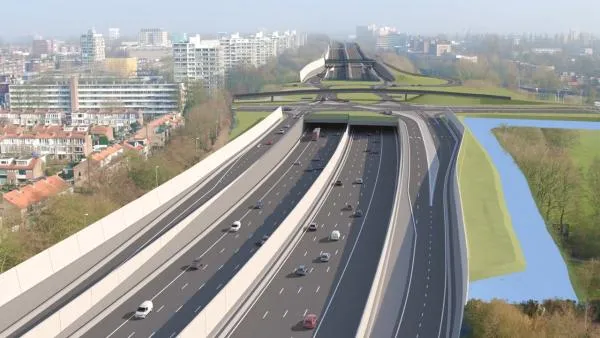
HOCHTIEF Selected for Landmark Dutch Highway Project
In a significant milestone for Dutch infrastructure development, Rijkswaterstaat (RWS)—the executive agency of the Dutch Ministry of Infrastructure and Water Management—has officially signed a major highway contract with the GelreGroen consortium. This public-private partnership marks a transformative project aimed at strengthening the country’s transportation network, particularly in the Arnhem region. The project stands among the largest and most ambitious highway upgrades in the Netherlands to date, with comprehensive responsibilities spanning planning, financing, construction, and long-term maintenance until 2051.
The GelreGroen joint venture is composed of several internationally recognized players in infrastructure and investment. The ownership structure of the consortium reflects the collaboration of both technical and financial expertise: HOCHTIEF and John Laing each hold a 40% stake, while Dutch construction company Dura Vermeer and Belgian firm BESIX each contribute with 10% ownership.
The core consortium responsible for executing the design, construction, and maintenance of the highway infrastructure is slightly different and evenly distributed. HOCHTIEF, Dura Vermeer, BESIX, and Dutch dredging and marine engineering company Van Oord each hold an equal 25% share in the construction consortium. This balance of international and local expertise ensures not only engineering excellence but also alignment with Dutch environmental and operational standards.
Project Scope and Timeline
The project, located in the Arnhem-Nijmegen metropolitan area in the province of Gelderland, centers around the expansion and enhancement of two key highway routes: the A12 and the A15. The initiative will extend the A15 highway by 12 kilometers, providing a much-needed connection to the A12 and thereby closing a critical gap in the Dutch motorway network. In addition to this new stretch, approximately 23 kilometers of the A12 and A15 will be widened to accommodate increasing traffic volumes, improve safety, and reduce congestion.
The scale of work includes not only roadway expansion but also the construction of a wide range of supporting infrastructure. This includes 45 bridge structures, 10 major traffic interchanges, and an extensive system of noise barriers to mitigate the impact of the highway on nearby residential areas. The centerpiece of the project is a new bridge spanning the Pannerdensch Canal—a critical link in the project—measuring approximately 2.5 kilometers in length. This bridge is expected to become a landmark structure in the Dutch highway system, designed to balance functionality with environmental integration.
Originally awarded in 2020, the contract faced multiple legal appeals that delayed the start of construction. Following a resolution by the Supreme Administrative Court, the path has now been cleared for work to begin. The updated timeline sets the start of construction for January 2026. Once underway, the project will require several years of coordinated work, with the extended A15 and widened segments of the A12/A15 scheduled to open by the end of 2031.
Long-Term Operation and Maintenance

One of the distinguishing features of this project is its inclusion of long-term financing, operation, and maintenance within the scope of the contract. Under the terms of the agreement, GelreGroen will not only build the infrastructure but will also be responsible for maintaining and operating the upgraded highway until 2051. This 25-year commitment after construction ensures a high standard of quality and accountability throughout the lifespan of the project.
Such long-term integrated contracts are increasingly favored in large-scale infrastructure development due to their alignment of incentives. Because the same entities responsible for construction are also charged with long-term operation, they have a vested interest in building durable, efficient, and low-maintenance infrastructure from the outset.
A Focus on Sustainability: “GelreGroen”
Sustainability is not merely a feature of this project—it is a central tenet. The name of the consortium itself, “GelreGroen,” is a reflection of this focus. “Groen,” which translates to “green” in Dutch, symbolizes the project’s commitment to environmental protection and sustainable development. The “nature-inclusive design” approach embedded in the planning and execution phases goes beyond regulatory compliance. It is a proactive stance aimed at minimizing environmental impact while enhancing ecological value.
Key aspects of this sustainable approach include the efficient use of materials, recycling and reuse of construction components, and integration of eco-friendly building methods. During the construction phase, particular attention will be given to reducing CO₂ emissions and minimizing the carbon footprint of operations. Additionally, the design will incorporate elements such as green bridges and wildlife corridors to maintain and even improve biodiversity in the affected areas.
Noise mitigation, often a concern in large road infrastructure projects, is being addressed through the installation of extensive and well-designed noise barriers. These will not only reduce the auditory impact for nearby communities but also act as windbreakers and visual buffers, contributing to the integration of the highway into the surrounding landscape.
Moreover, the bridge over the Pannerdensch Canal is being designed with sustainability in mind. Innovative engineering will ensure that it meets high standards for durability and resource efficiency while minimizing disruption to the waterway and adjacent habitats.
Strategic Importance for Dutch Mobility
The strategic impact of this highway project cannot be overstated. The Arnhem-Nijmegen region is a vital economic and logistical hub, and the improved infrastructure will enhance connectivity not just locally but nationally. By closing the missing link between the A15 and A12, the project will streamline traffic flows between the Port of Rotterdam—the largest seaport in Europe—and the eastern provinces and neighboring Germany. This upgrade is expected to significantly reduce travel times, improve logistics efficiency, and support economic growth throughout the region.
In addition to freight transport, the project will have a substantial impact on daily commuting patterns. With increased capacity and more efficient routes, the upgraded highway system is expected to alleviate existing bottlenecks, reduce delays, and improve overall road safety.
International Collaboration with Local Impact
The GelreGroen highway project exemplifies how international collaboration can deliver high-quality infrastructure with significant local benefits. HOCHTIEF, a globally recognized leader in complex infrastructure projects, brings engineering expertise and project management experience to the table. John Laing contributes deep knowledge of infrastructure investment and long-term asset management. Local partners Dura Vermeer and Van Oord ensure that the project remains firmly grounded in Dutch best practices and local stakeholder engagement.
BESIX, with its dual base in Belgium and the Netherlands, adds technical capability and regional familiarity, helping ensure seamless cooperation across borders. The collective strengths of the consortium members create a synergy that will be vital for overcoming the technical, logistical, and environmental challenges associated with such a large-scale project.
With construction set to begin in 2026, the coming years will witness one of the Netherlands’ most significant infrastructure endeavors unfold. Once completed, the extended and upgraded A15 and A12 highways will not only offer improved transportation efficiency but will also stand as a model for sustainable, long-term infrastructure development. The GelreGroen project is not just about roads—it is about connecting regions, enhancing quality of life, protecting the environment, and setting new standards for how modern infrastructure should be built and maintained.




